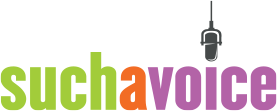
Before we dive into all the different programs out there, let’s start with the basics. A Digital Audio Workstation — or DAW — is simply the software you use to record, edit, and produce your audio. If you’ve ever opened up a program to record your voice, trim out a mistake, add a little compression, or export a file for a client, congratulations—you’ve already been using a DAW.
Think of it like the toolbox on your computer or phone that makes your voice-over sound clean, polished, and ready to send. Some DAWs are super simple, others are loaded with features, and the right one for you often comes down to how you like to work and what your budget looks like.
If you’ve hung around the voice-over world for any length of time, you’ve probably heard about Audacity. It’s free, it’s simple, and it’s helped a lot of us get started recording auditions and jobs without spending a dime. For many voice actors, it’s all they’ll ever need. You can record, edit, and deliver clean files with zero upfront cost…what’s not to love?
But at some point, you might start wondering, “Should I try something else? Is there a DAW that could make my life easier or my workflow faster?” The good news is that there are plenty of other options out there, and you don’t have to be an audio engineer to use them.
Let’s chat about some of the most popular alternatives voice actors use and why they might be worth checking out, plus a few ways to record on your phone when you’re on the go.
Adobe Audition – The Crowd Favorite
One of the most talked-about DAWs among voice actors is Adobe Audition. It’s part of the Adobe Creative Cloud, which means it plays really nicely with other Adobe programs like Premiere Pro.
The big draw? It’s built for speed and flexibility. The interface is clean, the editing tools are powerful, and the noise reduction features, especially the spectral display, make cleaning up audio way easier. Mouth clicks, hums, weird background noise? Gone with just a few clicks.
The catch? It’s subscription-based, currently around $22/month. That can feel pricey, but if you’re booking regularly, many pros find it worth the investment for the time it saves.
Reaper – The Budget Powerhouse
If you like the idea of upgrading but don’t want a monthly bill, Reaper might be your new best friend. It’s a super flexible DAW that runs on both Mac and PC, and you can fully customize it to fit your workflow.
It’s also very affordable, around $60 for a personal license, and the trial version is fully functional. A lot of VO folks love that it’s lightweight and fast, even on older computers.
Now, full disclosure: Reaper looks a little intimidating when you first open it. The interface isn’t as “friendly” out of the box as Audacity or Audition. But once you get the hang of it, or grab one of the VO templates floating around online, it’s incredibly powerful.
TwistedWave – Sleek and Simple
For Mac users who just want something clean and straightforward, TwistedWave is a fan favorite. It’s not a full multitrack DAW; it’s designed mainly for single-track voice work, which is perfect for most VO sessions.
It’s easy to use right away, and its batch processing is fantastic. If you’ve ever had to normalize and export a bunch of files at once, TwistedWave can do it in minutes. Bonus: there’s even an iPad and browser version for recording on the go.
The only downside? It’s Mac-focused, so PC users will have to look elsewhere. But if you’re in the Apple ecosystem, it’s a fantastic tool.
Pro Tools – The Studio Standard
If you’ve ever been in a big music or post-production studio, you’ve probably seen Pro Tools. It’s the industry standard in those worlds, and some voice actors use it for that reason.
For high-end projects or clients who request Pro Tools compatibility, it’s a solid option. It’s also insanely powerful; there’s basically nothing you can’t do in it.
But let’s be real: for most voice actors, it’s overkill. It’s expensive, the learning curve is steep, and unless you’re mixing music or doing a ton of complex audio work, you probably don’t need it.
Ocenaudio – Another Freebie
Not ready to spend money? Ocenaudio is another free DAW that’s worth checking out. It’s simple, lightweight, and some users find it faster than Audacity.
It has some nice built-in effects and makes it easy to clean up files without a lot of extra steps. The only drawback is that it’s not as widely used in the VO world, so finding tutorials or templates may take a little digging.
Hindenburg Journalist – Perfect for Narration and Podcasts
If you do a lot of narration or podcasting, Hindenburg Journalist might be a hidden gem. It’s built specifically for spoken-word audio, and it shows.
The software auto-levels your tracks, has a super-easy editing workflow, and is designed for voices rather than music. It’s a bit niche, and you may not need it if you’re mostly doing commercials or character work, but for narration-heavy projects, it’s a dream.
What About Recording on Your Phone?
Sometimes you’re traveling or stuck away from your booth, and a last-minute audition pops up. Good news, there are solid options for recording directly on your phone.
For iPhone users, TwistedWave’s mobile app is a lifesaver. It lets you record, edit, and even apply basic processing right from your phone. Pair it with a decent travel mic, and you can deliver audition-quality audio on the fly.
Another popular option is Ferrite Recording Studio (iOS). It’s designed for podcasters and journalists, but works great for VO. It has multi-track capabilities and built-in editing tools, all optimized for touchscreens.
If you’re on Android, WaveEditor is a strong choice. It offers recording and editing in one app and supports plenty of file formats.
And if you want something more robust on mobile, check out Audio Evolution Mobile Studio (available on Android and iOS). It’s closer to a full DAW, with multi-track recording, effects, and editing tools. For folks who need more control while traveling, it’s a solid option that bridges the gap between a simple voice memo app and a desktop DAW.
Even the basic voice memo apps built into your phone can work in a pinch; just make sure you’re in a quiet space and clean it up later.
Are phone apps a replacement for a treated home studio? Not really. But they’re fantastic for emergencies or when you need to record a quick audition while you’re on the road.
So, Which DAW Is Best?
Here’s the truth: the “best” DAW is the one that makes your life easiest, fits your budget, and helps you deliver clean audio to your clients. Some folks stay with Audacity forever and never feel limited. Others upgrade to Audition or Reaper and swear they’ll never go back.
The most important thing is how comfortable you feel using it. A DAW is just a tool; your clients care about the quality of your final product, not the software you used to make it.
Exploring new DAWs can feel intimidating at first, but it’s also exciting. Each one has its own personality and strengths. Try a few demos, experiment with a phone app or two, and see what fits your workflow. Whether you stick with Audacity, upgrade to a more powerful DAW, or add a mobile option like Audio Evolution for travel days, the goal is the same: deliver great audio and make the process as stress-free as possible.
P.S. If you haven’t yet taken our introductory voice-over class, where we go over everything one needs to know about getting started in the voice-over industry, sign up here!
P.P.S If you want to learn more from VO experts and grow the knowledge you already have, join our VO Pro group!




